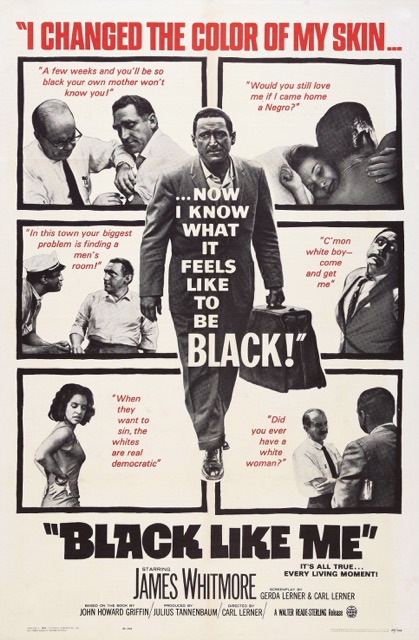You are standing across one from one of the filming locations for Black Like Me. The film, released on May 20, 1964, was based on John Howard Griffin’s book about his experience in 1959 of medically darkening his skin to pass himself off as a black man in the South. Griffin provided an unflinching view of the Jim Crow South and hoped to “destroy the communication barriers between Blacks and whites, to show the oppressor what happens when he is oppressed.”
The book was a hit, selling 10 million copies. The film version was directed by Carl Lerner and starred James Whitmore. Because of the book’s notorious reputation in the South and among white extremists, filming was done in secret using the working title “No Man Walks Alone” to protect the film crew from violence. The film opened to mixed reviews. The Afro American, the longest running Black family owned newspaper in the county, declared the film was “terrible,” noting that it only dealt with segregation on the surface level and that stereotypes of Black people with “obvious honest intentions” undermined it.
Though reviled by Southern whites, Griffin himself was propelled into the spotlight and had given more than 1,000 lectures as the Civil Rights Movement accelerated. However, he felt awkward about his position as a white spokesman during the Civil Rights Movement and began curtailing his speaking engagements, finding it “absurd for a white man to presume to speak for black people when they have superlative voices of their own.”
FILMANDO “NEGRO COMO YO” EN UPPER MARLBORO
Estás parado frente a uno de los lugares de rodaje de Black Like Me. La película, estrenada el 20 de mayo de 1964, se basó en el libro de John Howard Griffin sobre su experiencia en 1959 de oscurecer médicamente su piel para hacerse pasar por un hombre negro en el sur. Griffin proporcionó una visión inquebrantable del sur de Jim Crow y esperaba “destruir las barreras de comunicación entre negros y blancos, para mostrar al opresor lo que sucede cuando es oprimido”.
El libro fue un éxito, vendiendo 10 millones de copias. La versión cinematográfica fue dirigida por Carl Lerner y protagonizada por James Whitmore. Debido a la notoria reputación del libro en el sur y entre los extremistas blancos, la filmación se realizó en secreto utilizando el título provisional “No Man Walks Alone” para proteger al equipo de filmación de la violencia. La película se abrió a críticas mixtas. The Afro American, el periódico de propiedad de la familia negra más antiguo del condado, declaró que la película era “terrible”, señalando que solo se ocupaba de la segregación a nivel superficial y que los estereotipos de las personas negras con “intenciones honestas obvias” la socavaban.
Aunque era menospreciada por los blancos del sur, el propio Griffin fue impulsado al centro de atención y había dado más de 1,000 conferencias a medida que el Movimiento por los Derechos Civiles se aceleraba. Sin embargo, se sintió incómodo por su posición como portavoz blanco durante el Movimiento por los Derechos Civiles y comenzó a restringir sus compromisos de hablar, encontrando “absurdo que un hombre blanco presuma de hablar por los negros cuando tienen voces superlativas propias”.
SHARE
Main St. & Pratt St.
Upper Marlboro, Maryland 20772
Directions









